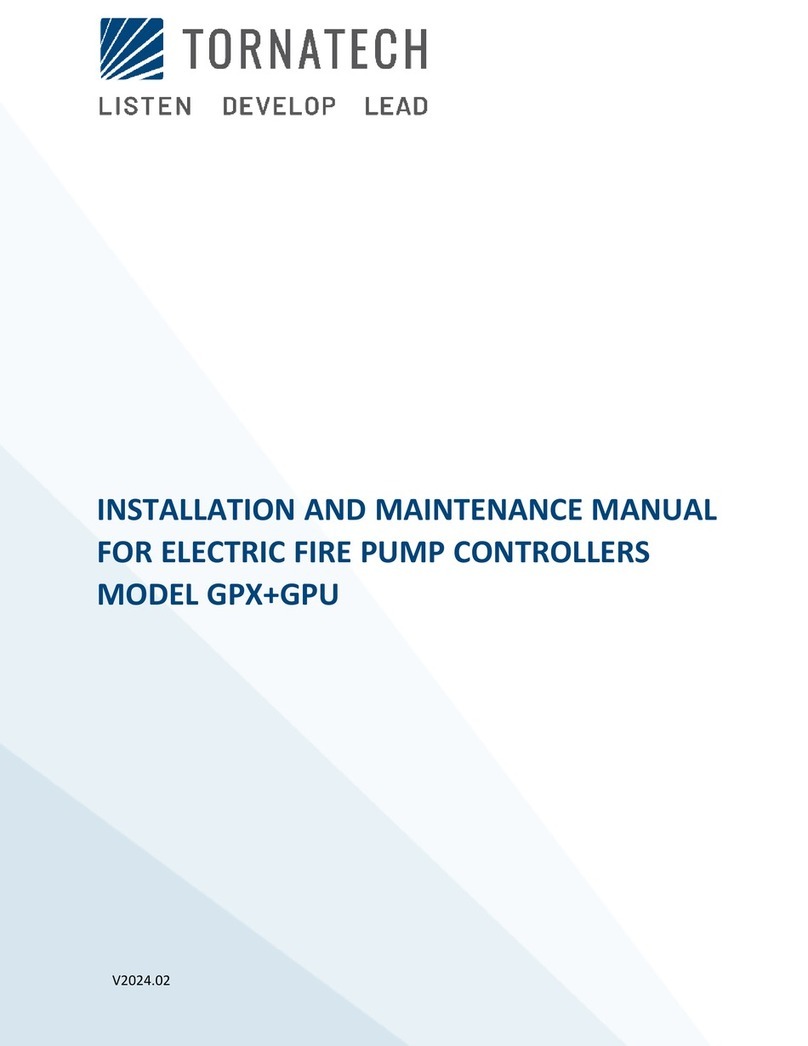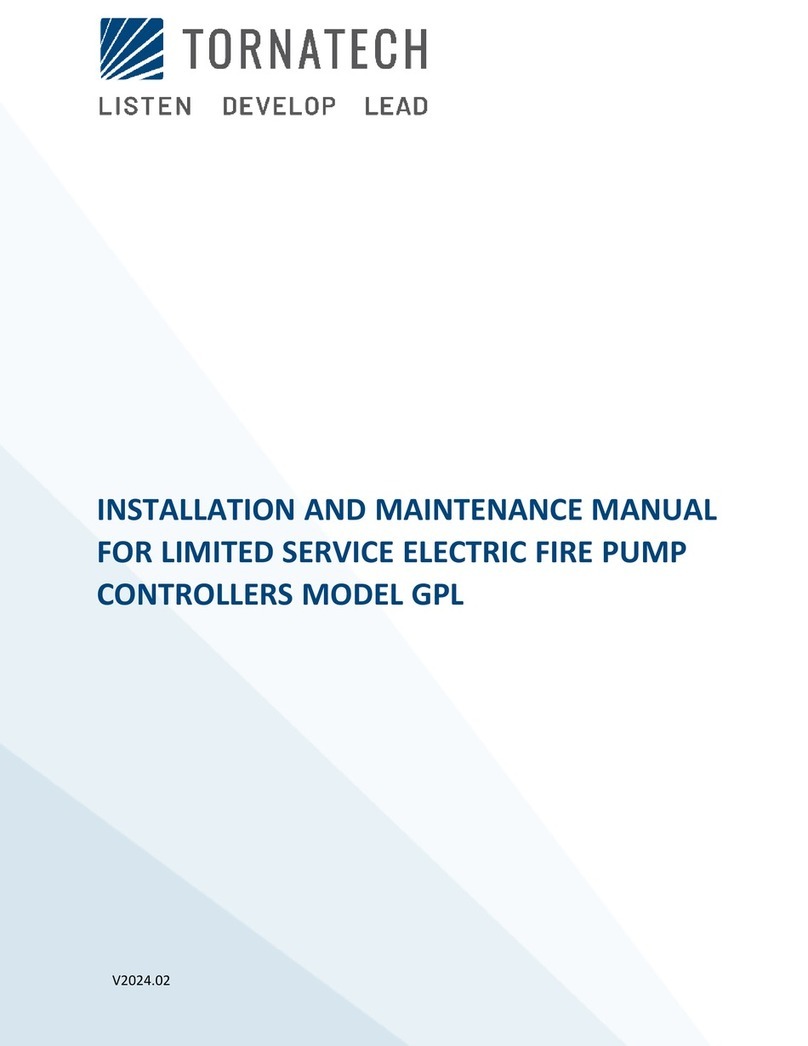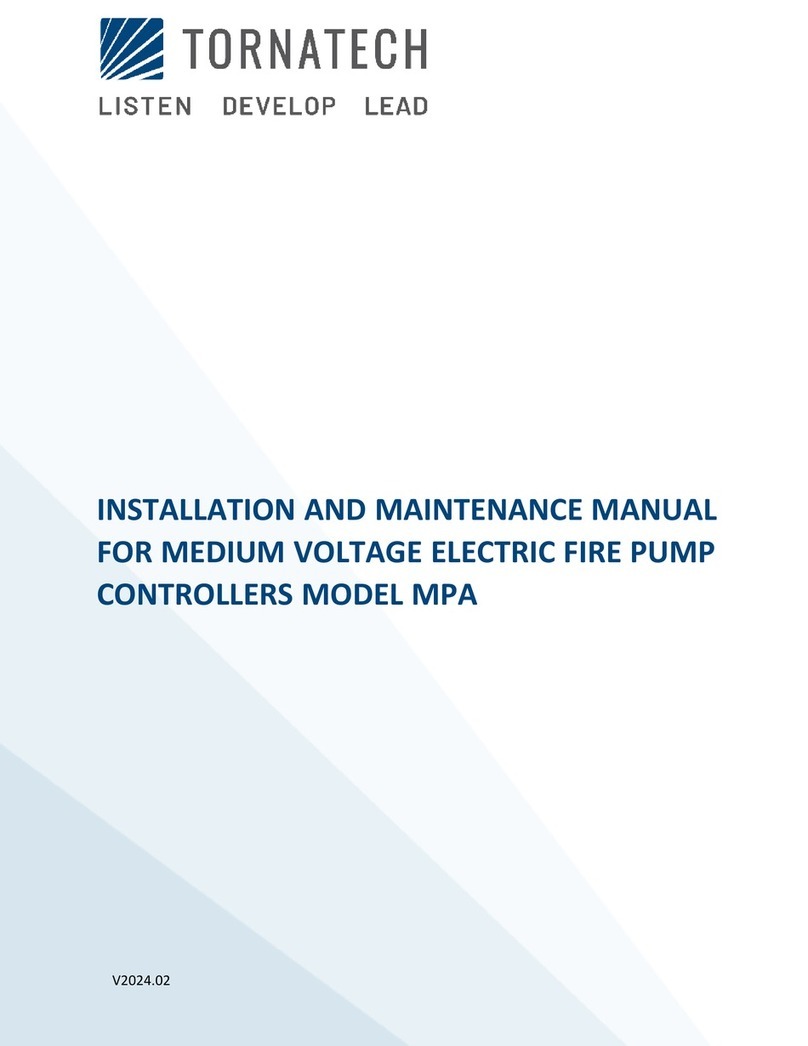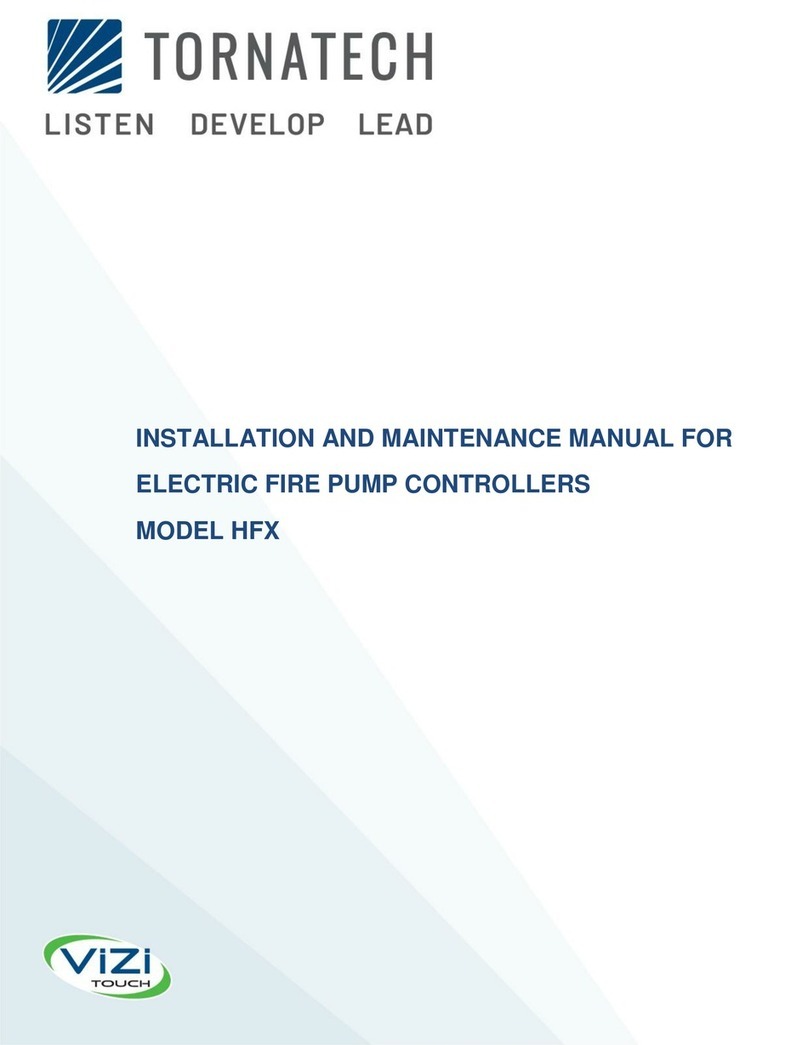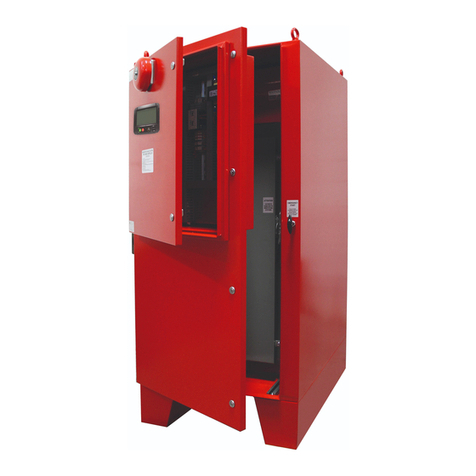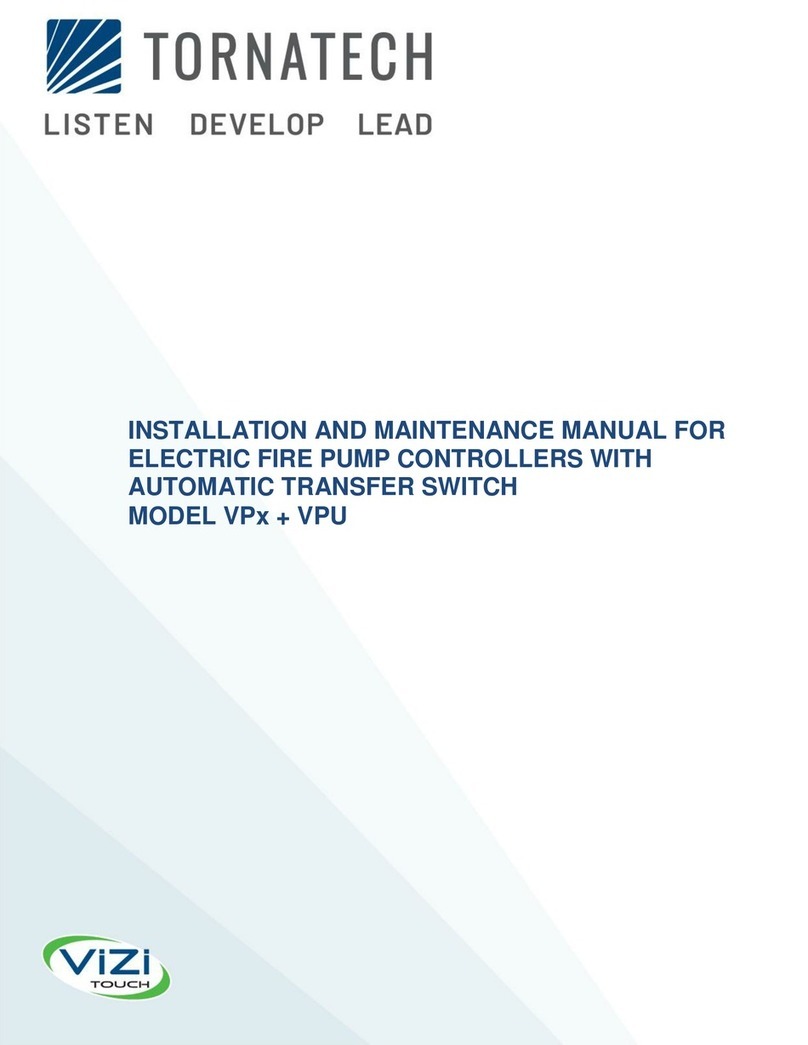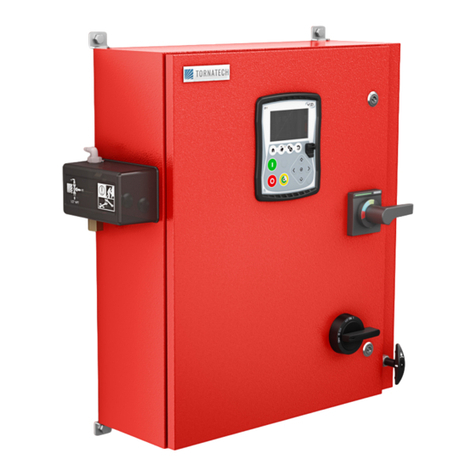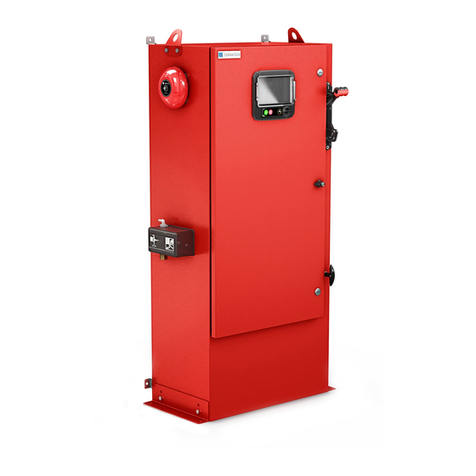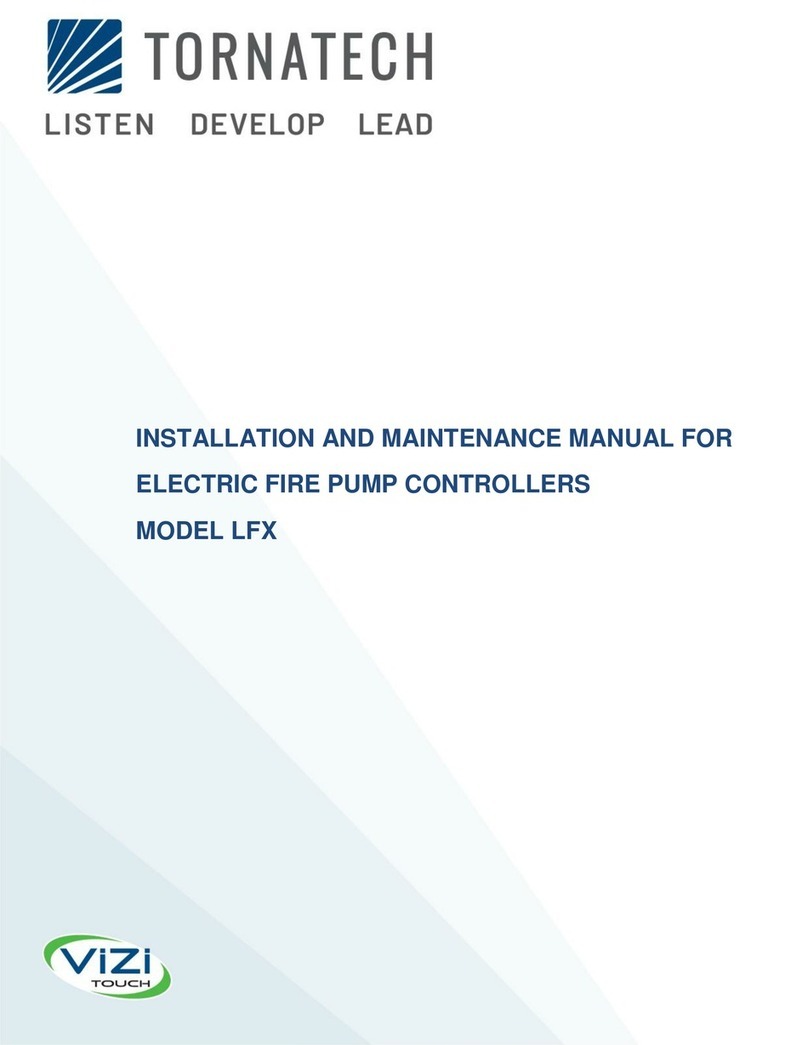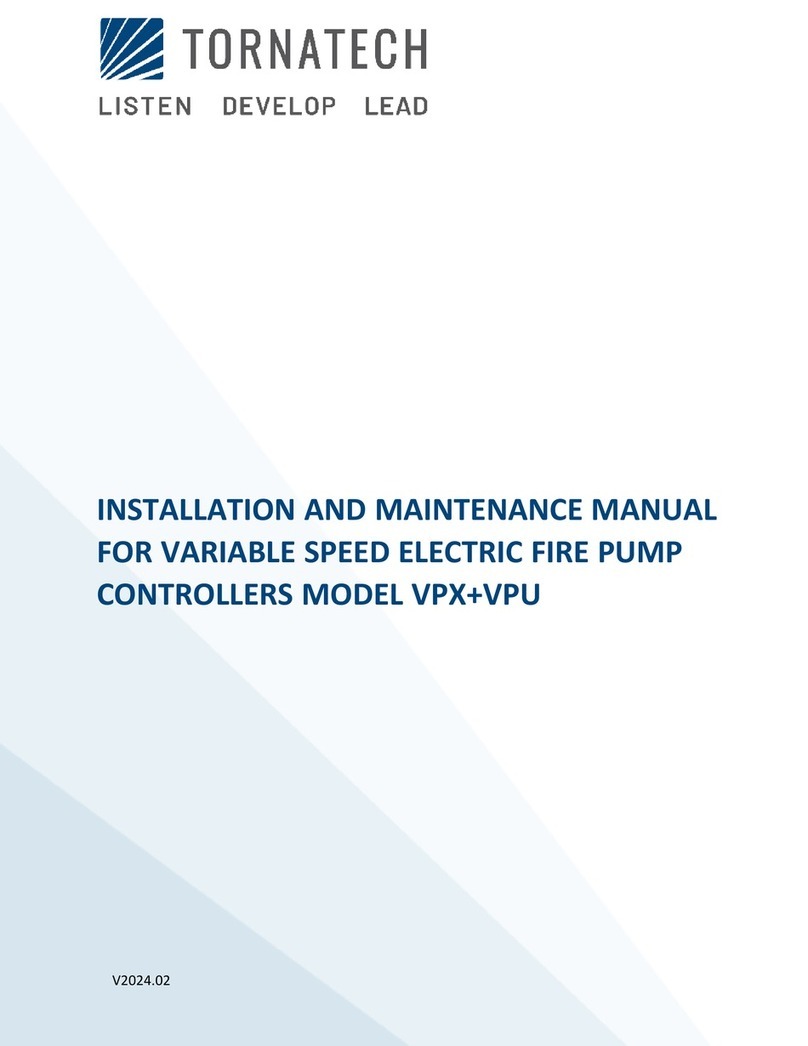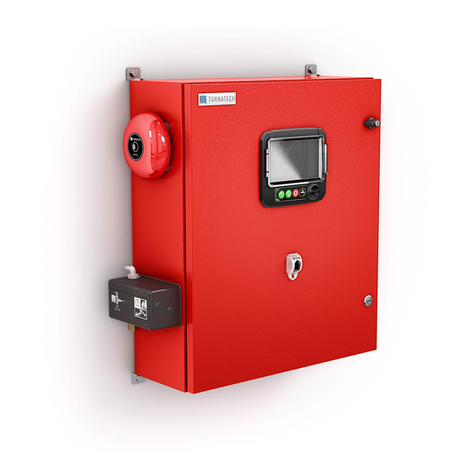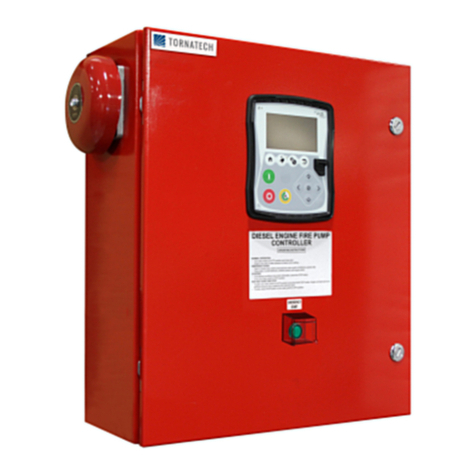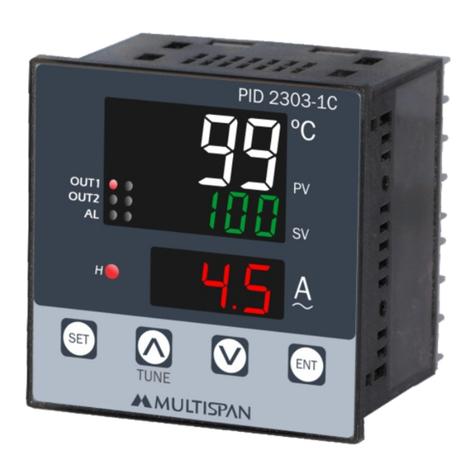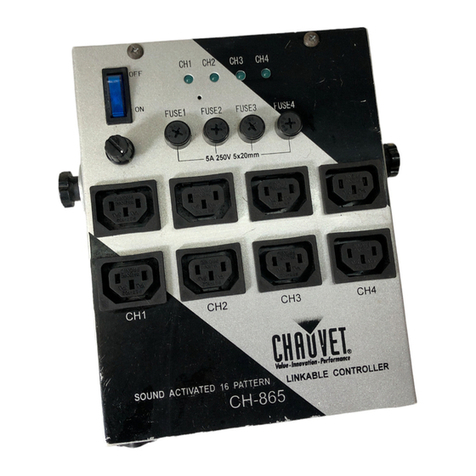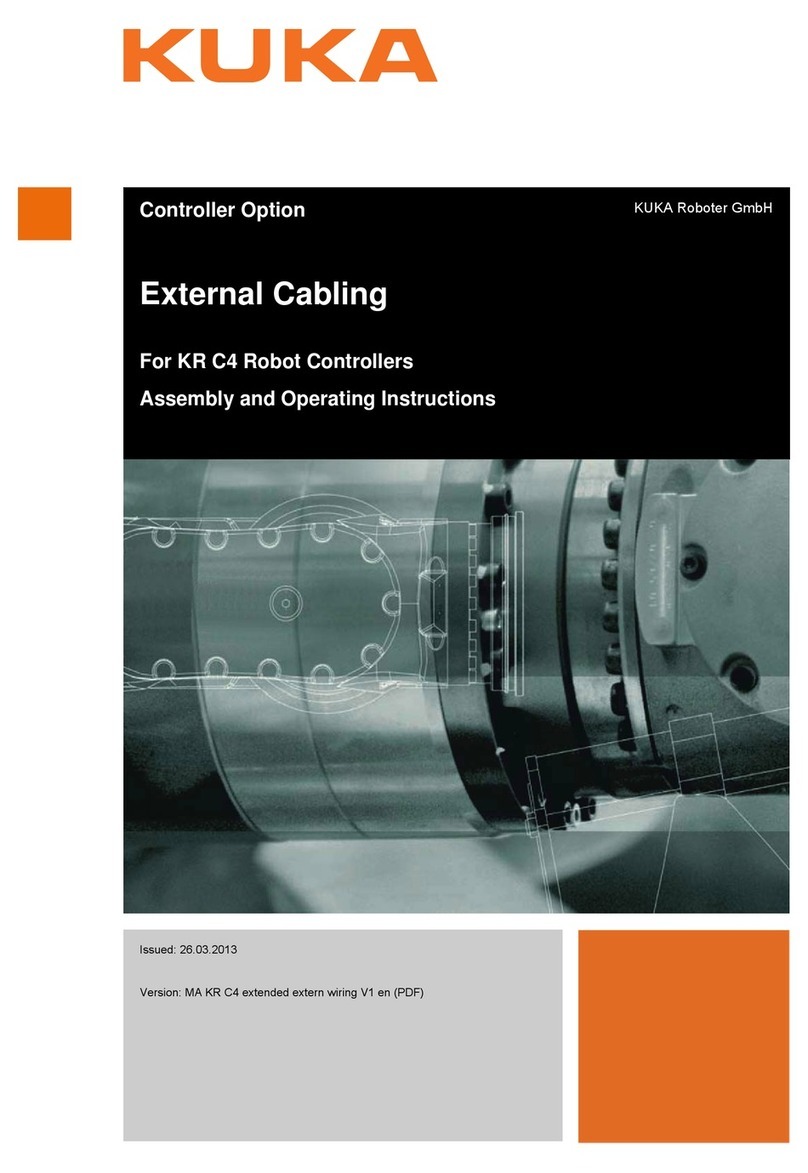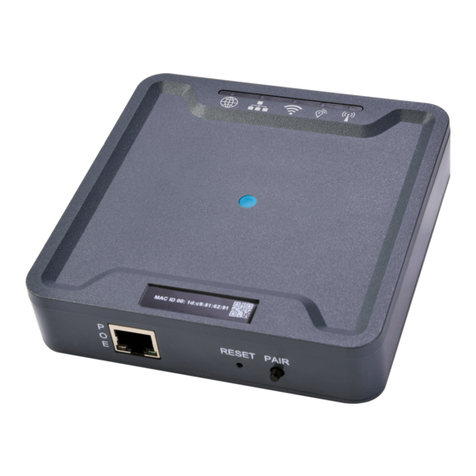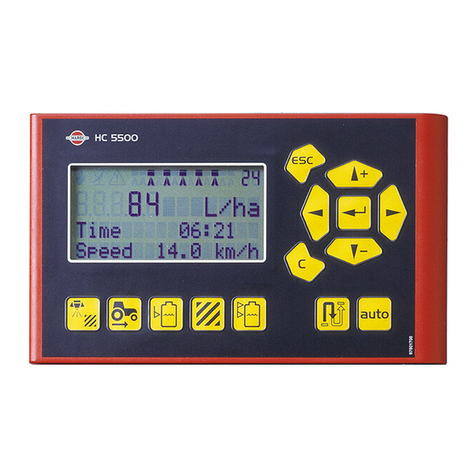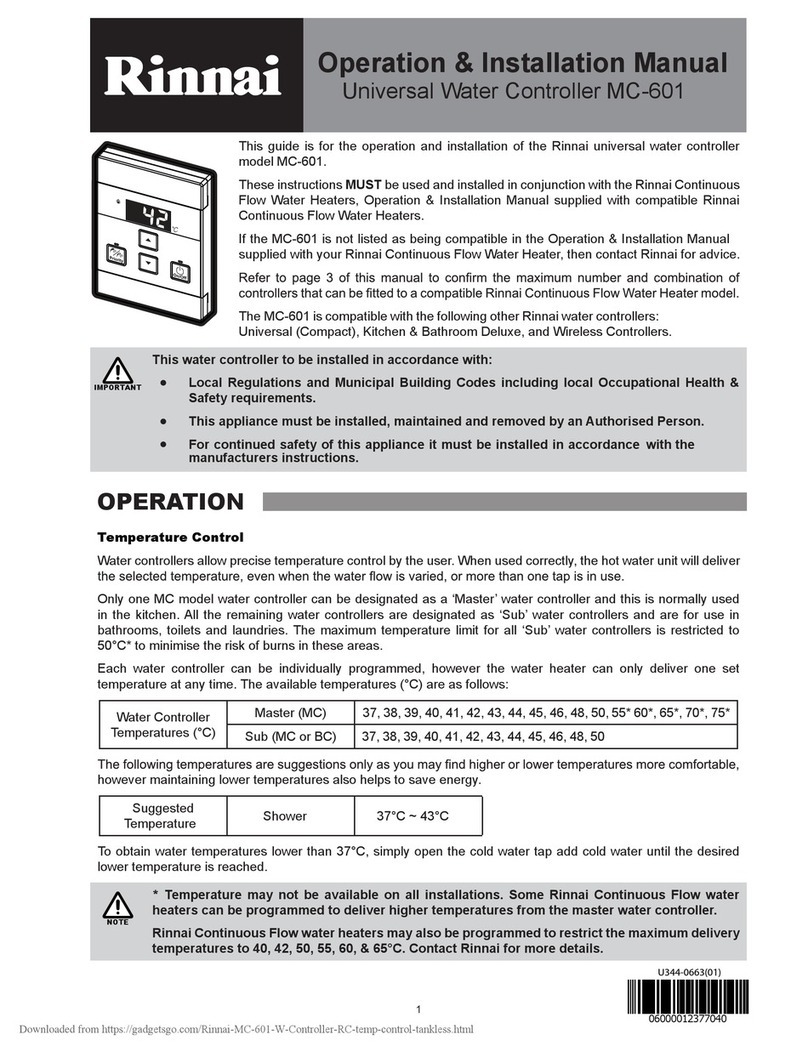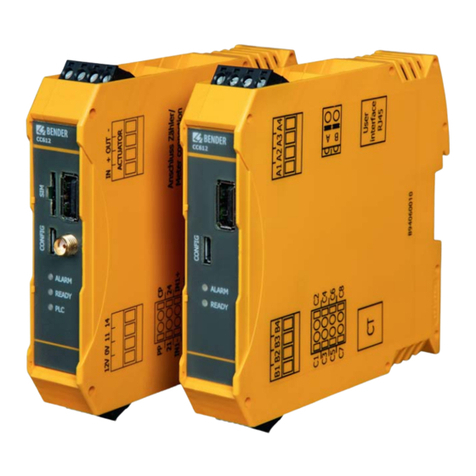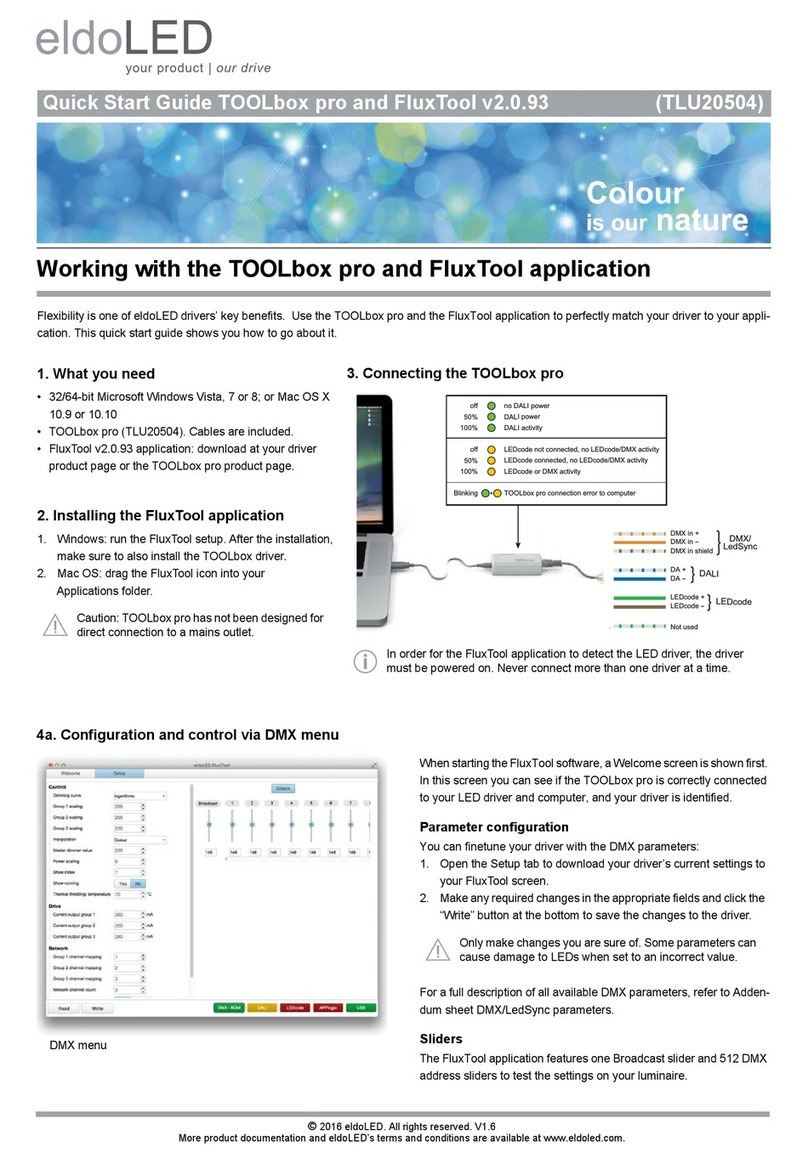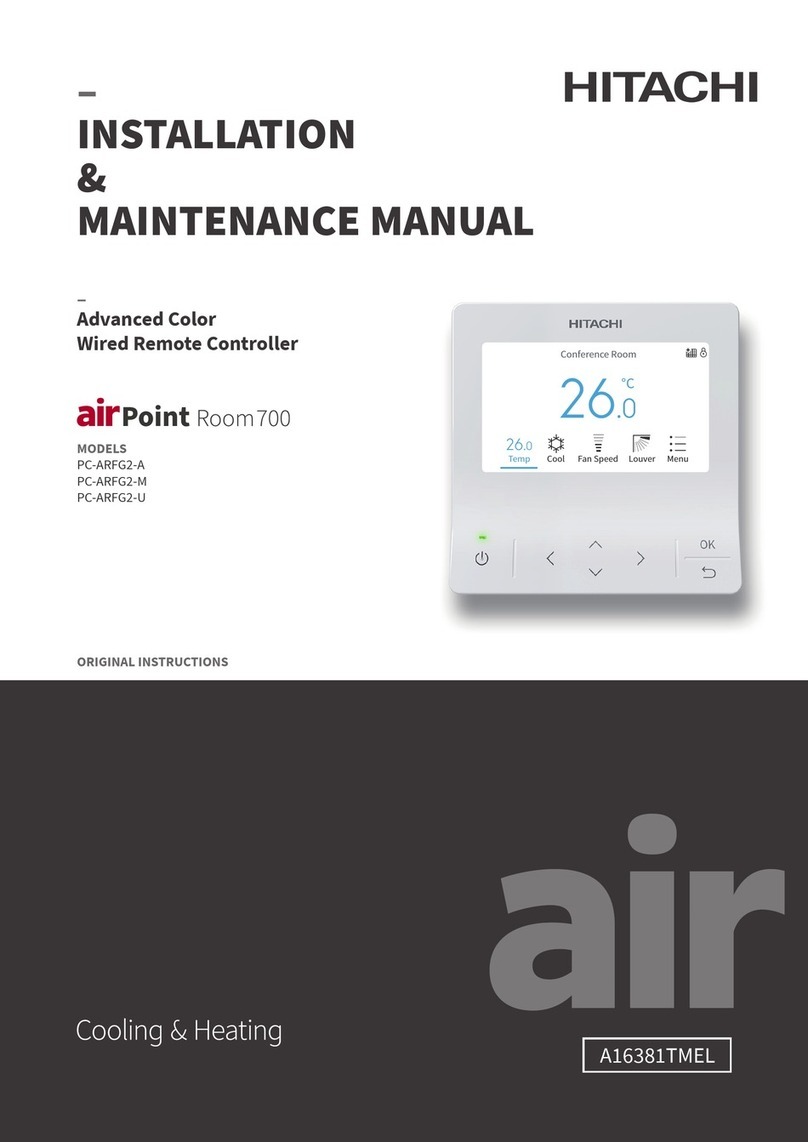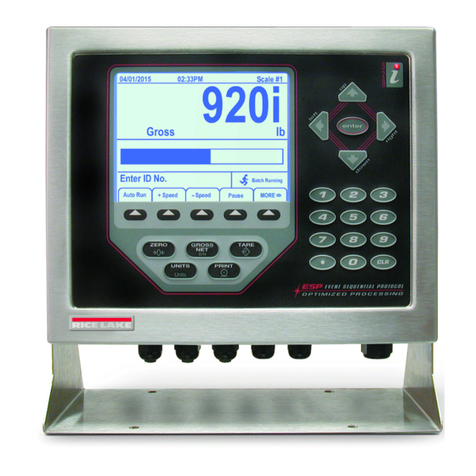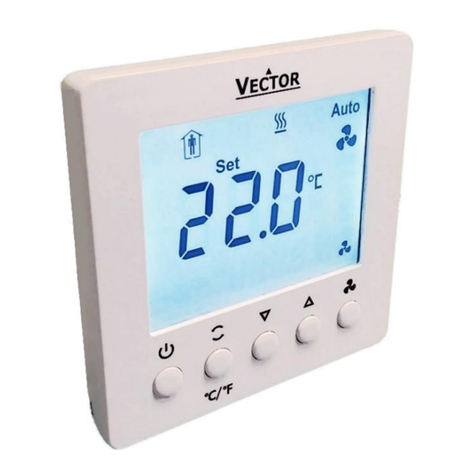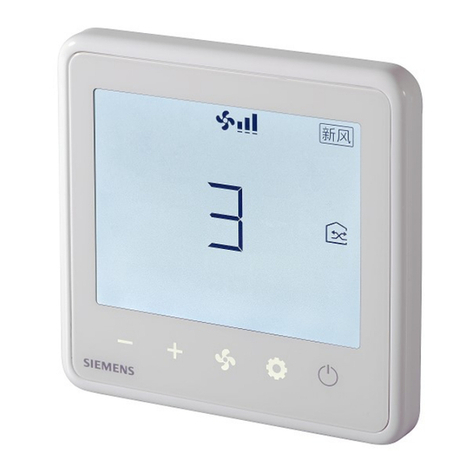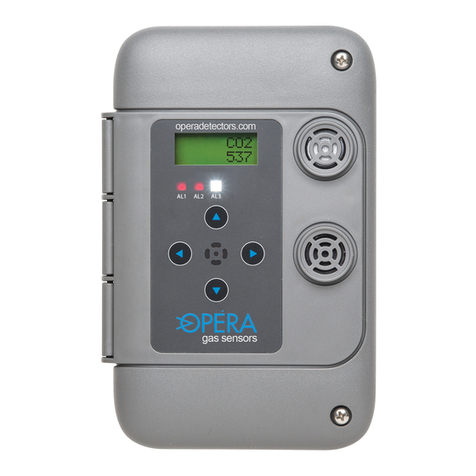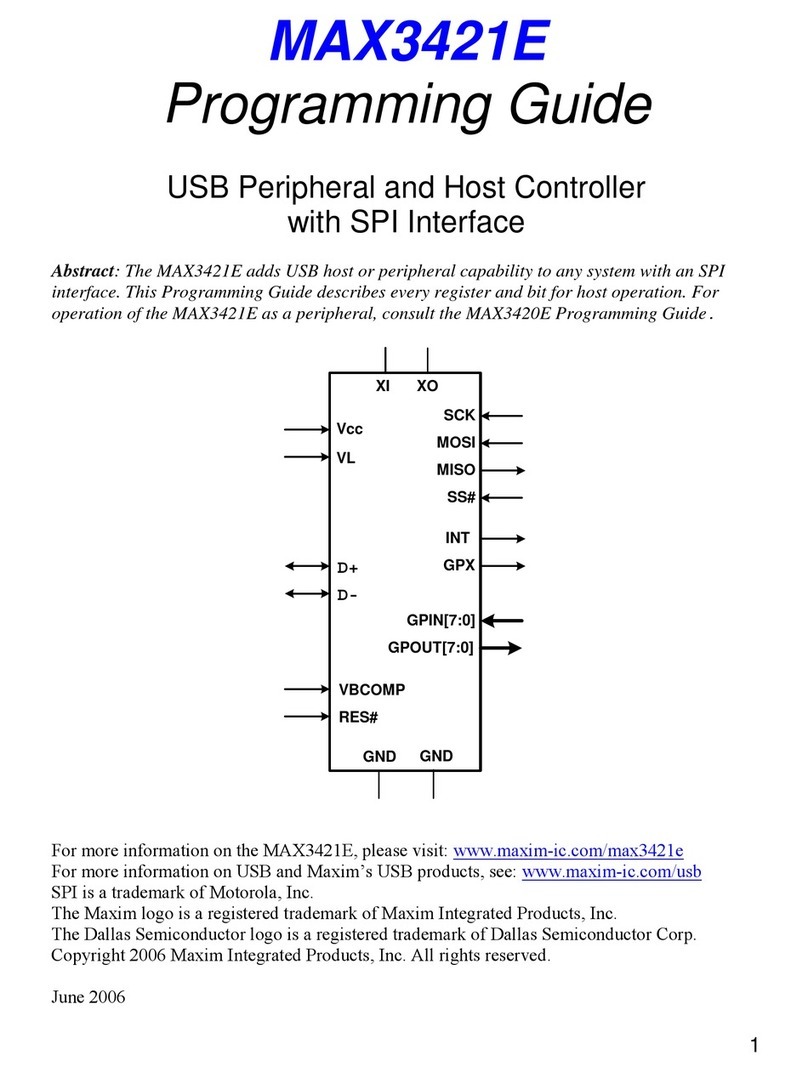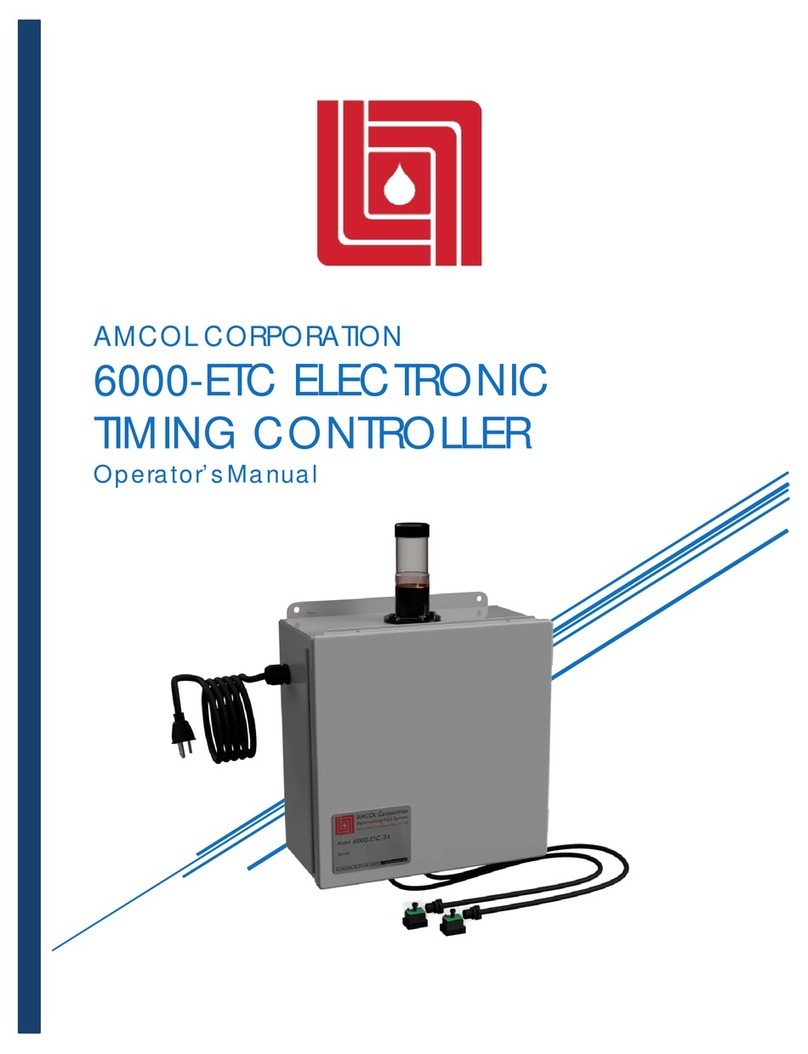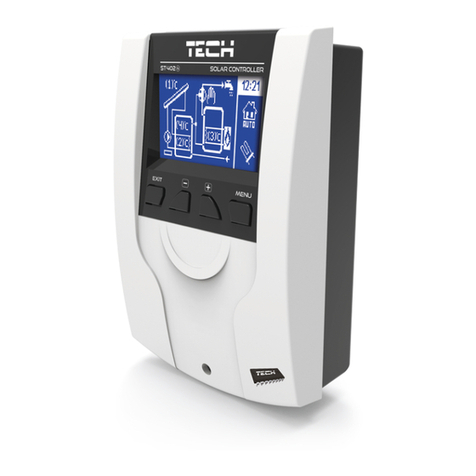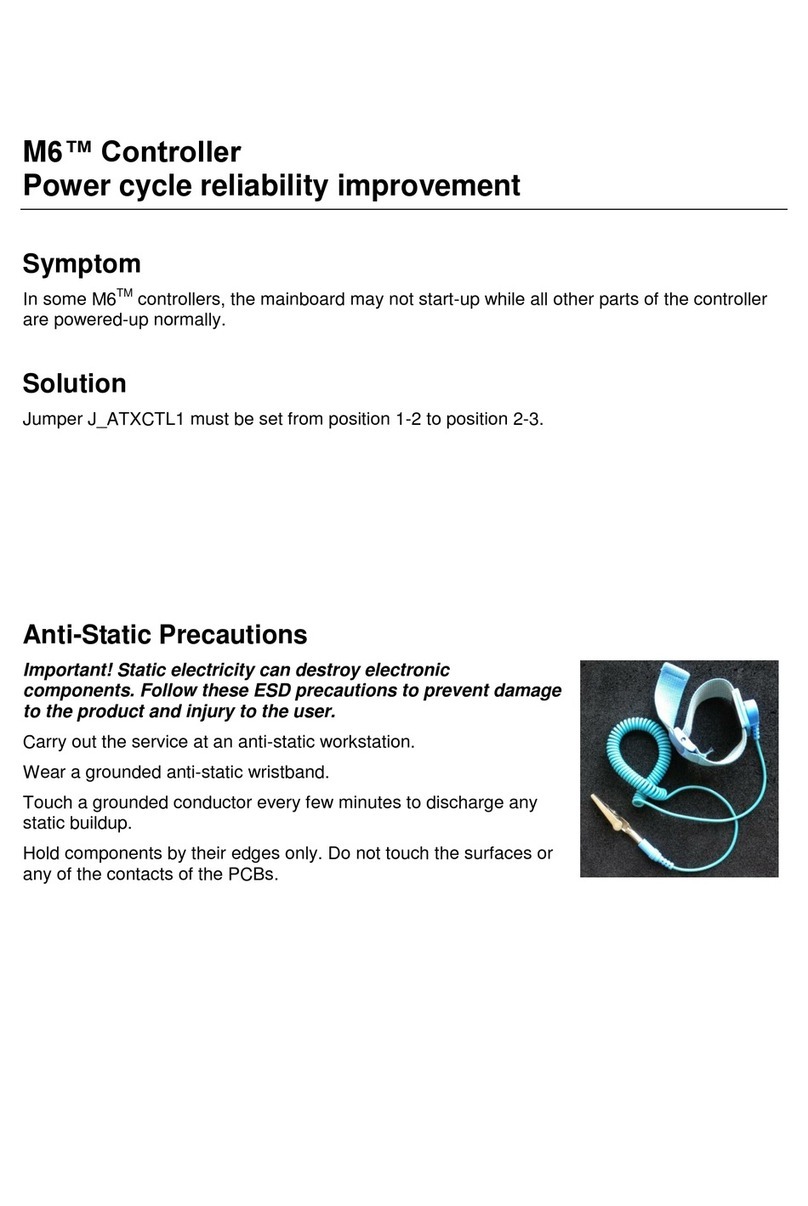Tornatech GFD Manual

1
INSTALLATION AND MAINTENANCE MANUAL FOR
DIESEL ENGINE FIRE PUMP CONTROLLERS
MODEL GFD

2
GFD-Manual-EN v1.4.0.0
Table of Contents
1. Introduction
2. Installation
3. Main Features
4. Home
5. Alarms
6. Configuration
7. History
8. Technical Documents

3
Table of Contents
Introduction......................................................................................................................................................................5
Types of Diesel Engine Fire Pump Controllers..........................................................................................................5
Methods of Starting/Stopping.....................................................................................................................................5
Installation.......................................................................................................................................................................7
Location......................................................................................................................................................................7
Mounting ....................................................................................................................................................................7
Storage.......................................................................................................................................................................7
Wiring and Connections.............................................................................................................................................7
Water Connections.....................................................................................................................................................7
Electrical Wiring .........................................................................................................................................................8
Electrical Connections................................................................................................................................................8
Energy Consumption..................................................................................................................................................8
Sizing..........................................................................................................................................................................8
Incoming Power Connections ....................................................................................................................................8
Circuit protection ........................................................................................................................................................8
Terminal Strip Descriptions........................................................................................................................................9
Quick Start-Up Guide...............................................................................................................................................10
Main Features ...............................................................................................................................................................19
The ViZiTouch..........................................................................................................................................................19
Alarm Bell.................................................................................................................................................................20
First Setup................................................................................................................................................................20
Home.............................................................................................................................................................................21
Home (Membrane button)........................................................................................................................................21
Screen Saver ...........................................................................................................................................................23
Alarms...........................................................................................................................................................................24
Alarms (Membrane button) ......................................................................................................................................24
Configuration.................................................................................................................................................................28
Config (Membrane button).......................................................................................................................................28
NumPad Page..........................................................................................................................................................29
Date and Time Page................................................................................................................................................29
User Login Page / KeyPad Page .............................................................................................................................30
Advanced Configuration Page .................................................................................................................................31
Details of the Advanced Configuration Page...........................................................................................................31
Volt-Current Calibration............................................................................................................................................31
Timers Page.............................................................................................................................................................33
Inputs/Outputs Configuration ...................................................................................................................................34
Inputs/Outputs Expansion board 1-2-3-4.................................................................................................................35
Update Program Page .............................................................................................................................................36
Factory Settings .......................................................................................................................................................37
Reset to Factory Settings Page ...............................................................................................................................38

4
The Sensors Pages..................................................................................................................................................38
Interlock Lockout......................................................................................................................................................41
History...........................................................................................................................................................................43
History (Membrane button) ......................................................................................................................................43
Details of the History Page ......................................................................................................................................44
Events Page.............................................................................................................................................................44
Download to USB Device.........................................................................................................................................44
The Statistics............................................................................................................................................................46
All Time Statistics.....................................................................................................................................................46
Pressure Curves ......................................................................................................................................................46
Graphical Mode........................................................................................................................................................46
Textual Mode ...........................................................................................................................................................47
Technical Documents....................................................................................................................................................48

5
Diesel engine fire pump controllers are designed to automatically start a diesel engine driven fire pump upon
detection of a pressure drop in the fire protection system. A diesel engine fire pump controller provides automatic &
manual starting and stopping. An automatic start is controlled by a pressure transducer or by remote automatic
devices such as a deluge valve. A manual start is controlled by remote manual button or by controller pushbutton.
The automatic shutdown option provides a 30-minute automatic stop after automatic start once all starting causes
have returned to normal. The diesel engine fire pump controller includes two battery chargers to ensure the engine
batteries are continuously charged.
Types of Diesel Engine Fire Pump Controllers
FIRE PUMP CATALOG NUMBER
MODEL No. EXAMPLE: GFD-12-120
Model Prefix: GFD
Battery Voltage: 12=12V, 24=24V
Incoming Voltage: 120=110/120V 50/60Hz, 220=208/240V 50/60Hz
Methods of Starting/Stopping
The controllers are available as combination automatic / non-automatic with provision for manual or automatic
shutdown (an automatic shutdown is only possible after an automatic start).
METHODS OF STARTING
AUTOMATIC START
The controller will start automatically on low pressure detection by the pressure sensor when the pressure drops
below the cut-in threshold.
MANUAL START
The engine can be started by pressing the CRANK 1 or and/or CRANK 2 push button, regardless of the system
pressure, when the Main Selector switch is in the HAND position. The Fuel Solenoid Valve will open as soon as a
CRANK button is pressed and will remain in this state.
REMOTE MANUAL START
The engine can be started from a remote location by momentarily closing a contact of a manual push button.
REMOTE AUTOMATIC START, DELUGE VALVE START
The engine can be started from a remote location by momentarily opening a contact connected to an automatic
device. The controller must be in automatic mode.
SEQUENTIAL START
In case of a multiple pump application, it may be necessary to delay the starting of each motor when there is a
water pressure drop to prevent simultaneous starting of all motors.
FLOW START, HIGH ZONE START
The pump can be started by opening/closing a contact on the FLOW/ZONE START/STOP input.
WEEKLY START
The engine can be started (and stopped) automatically at the preprogrammed time.
TEST START
The motor can be started manually by pressing the run test button.
Introduction

6
METHODS OF STOPPING
MANUAL STOP
Manual stop is done by pressing the STOP push button. Note that pressing the stop push button will stop the
engine only if all starting causes have disappeared.
AUTOMATIC STOP
The automatic stop is possible only after an automatic start and this function has been activated. When this
function is Enabled, the motor is automatically stopped 30 minutes (adjustable) after the restoration of the pressure
(above the cut-out threshold) given that no other run cause is present.
FLOW STOP, HIGH ZONE STOP
If the controller has been started by the FLOW/ZONE START/STOP input and the signal has returned to normal,
the motor will be stopped given that no other run cause is present.
EMERGENCY STOP
The emergency stop is always possible in any running condition and is done by positioning the main selector
-switch to the OFF position.

7
The controller is built in accordance with the latest edition of the National Fire Protection Association standard for
the Installation of Centrifugal Fire Pumps, NFPA No.20 (Centrifugal Fire Pumps 2016 Edition). The controller is
intended to be installed in accordance to NFPA 20-2016 and
in the USA National Electrical Code NFPA 70
In Canada Canadian Electrical Code, Part 1
Others Local Electrical Codes
This controller can be used with non-approved engine, using the optional control by analog senders (Magnetic
pickup, oil pressure and engine temperature senders, all shown using on-screen gauges on the ViZiTouch. Find
more information on the senders section of this manual.
Location
The controller shall be located as close as practical to the engine/motor it controls and shall be within sight of the
engine/motor. The controller shall be located or protected such that it will not be damaged by water escaping from
pump or pump connections. Current carrying parts of the controller shall be not less than 12 in. (305 mm) above the
floor level.
Working clearances around controller shall comply with NFPA 70, National Electrical Code, Article 110 or C22.1,
Canadian Electrical Code, Article 26.302 or other local codes.
The controller is suitable for use in locations subject to a moderate degree of moisture, such as a damp basement.
The pump room ambient temperature shall be between 39°F (4°C) and 104°F (40°C) (If a temperature option is
included, see the rating label for maximum temperature).
The standard controller enclosure is rated IP55. It is the installer’s responsibility to insure that either the standard
enclosure meets the ambient conditions or that an enclosure with an appropriate rating has been provided.
Controllers must be installed inside a building and they are not designed for outside environment. The paint color
may change if the controller is exposed to ultraviolet rays for a long period of time.
Mounting
The fire pump controller shall be mounted in a substantial manner on a single incombustible supporting structure.
Wall mounted controllers shall be attached to the structure or wall using all four (4) mounting ears provided on the
controller with hardware designed to support the weight of the controller at a height not less than 12 in. (305 mm)
above floor level. Floor mounted controllers shall be attached to the floor using all holes provided on the mounting
feet with hardware designed to support the weight of the controller. The mounting feet provide the necessary 12 in.
(305 mm) clearance for current carrying parts.
Storage
If the controller is not installed and energized immediately, Tornatech recommend following the instructions from the
chapter 3 of the NEMA ICS 15 standard.
Wiring and Connections
Water Connections
The controller must be connected to the pipe system according to the latest edition of NFPA20 and also to a drain
pipe. The water connections are on the left side of the controller. The connection to the system pressure is a Male
½ NPT. If a drain is present, the connection to the drain is a tapered connection for plastic tubing.
Installation

8
Electrical Wiring
The electrical wiring between the power source and the diesel engine fire pump controller shall meet the NFPA 20,
Chapter 12.3.5.1, 12.3.5.2 and 12.2.5.3, NFPA 70 National Electrical Code Article 695 or C22.1 Canadian Electrical
Code, Section 32-200 or other local codes.
Electrical Connections
A licensed electrician must supervise the electrical connections. The dimension drawings show the area suitable for
incoming power and motor connections. No other location shall be used. Only watertight hub fittings shall be used
when entering the cabinet to preserve the NEMA rating of the cabinet. The installer is responsible for adequate
protection of the fire pump controller components against metallic debris or drilling chips. Failure to do so may
cause injuries to personnel, damage the controller and subsequently void warranty.
Energy Consumption
Diesel Controller with boost charger
Model / State
120VAC
220/
240VAC
VDC Output
12VDC / @
No charge
1.0A
1.0A
13.8V
12VDC / @
Full charge*
6A
4A
24VDC / @
No charge
1.0A
0.5A
27.6V
24VDC / @
Full charge**
9A
6A
*12 amps through each battery
**10 amps through each battery
Sizing
Wiring between controller and engine (terminals 301,302,303,304,305,310,311,312,2,3,4,5) must be stranded
#14AWG as minimum.
Wiring between controller and engine (terminals 1,9,10,12) must be stranded #10AWG as minimum.
Wiring between controller and engine (terminals 6,8,11) must be stranded #8AWG as minimum.
Power supply wiring must be stranded #14 AWG as minimum.
Incoming power supply terminals are sized for #16 to #6 AWG wire.
Incoming Power Connections
Diesel engine driven fire pump controllers shall be powered by a dedicated source protected by a fuse or circuit
breaker. Verify the label on the cabinet to select the correct protection. Always follow this procedure when
connecting or disconnecting the controller: Connect both batteries before connecting the AC power. Disconnect the
AC power before disconnecting the batteries. Disconnecting the batteries while the AC is connected may result in
severe damage to the controller electronic boards.
Circuit protection
CB1 protects battery charger 1 and charger 2, and allows the AC power to be disconnected from the battery
chargers. CB2 protects control circuit from battery 1 and CB3 protects control circuit from battery 2.
Always follow this procedure when connecting or disconnecting the controller: Connect both batteries before
connecting the AC power. Disconnect the AC power before disconnecting the batteries.

9
Terminal Strip Descriptions
A-F : Alarm Output Terminals
(DPDT Relay, 11/21:Common, 12/22:Normally Closed,
14/24:Normally Open):
A: Controller Trouble (Fail safe)
B: Engine Run
C: Main SS in HAND/OFF position
D: Engine Trouble
E: Pump Room Alarm
F: Optional Output 1
G-T : Field Input Terminal
(Dry Contact Only: Voltage Free):
G: Low Fuel Level (NO)
H: Remote Automatic Start (NC)
I: Deluge Valve Start (NC)
J: Fuel Tank Leak (NO)
K: High Fuel Level (NO)
L: Engine RPM Magnetic Pickup
M: ECMS Elec. Ctrl. Switch
N: FIM Fuel Injection Malfunction
O: ECMW Elec. Ctrl. Warning
P: ECMF Elec. Ctrl. Fault
Q: PLD Low Suction Pressure
R: High Raw Water Temperature
S: Low Raw Water Flow
T: LET Low Engine Temperature
U : Engine Terminals :
The terminals are numbered according to the standard:
1 - FS : Fuel Solenoid Valve
(ETR - Energized To Run)
2 - ER : Engine Run contact
3 - OS : Engine Overspeed contact
4 - OP : Engine Oil Pressure contact
5 - WT : Engine Coolant Thermostat contact
6 - B1 : Battery #1 positive
8 - B2 : Battery #2 positive
9 - C1 : Start Contactor #1
10 - C2 : Start Contactor #2
11 - GND : Ground
12 - ST : Stop Fuel Solenoid Valve
(ETS - Energized To Stop)
V: Analog inputs / Solenoid Valve:
SOL V: Test Solenoid Valve
AI1: Discharge Pressure transducer
AI2: Optional additional Discharge Pressure transducer
AI3: Water Level or Suction Pressure transducer
AI4: Fuel Level analog input
AI5: Flow or Spare Temperature analog input
W: Optional Input for analog AC reading
X: CANBUS to IO cards
Y: CANBUS to ViZiTouch
Z: Factory reserved power connections

10
Quick Start-Up Guide
The rating label is the most important label. It must be read carefully to ensure the compatibility between the
controller and the installation.
Verify that the controller is installed securely to the wall, or on the mounting stand (optional). Verify the Main
Selector Switch is in the “OFF” position. This selector switch is also called the “HOA” and can be placed in 3
positions: “H” Hand/Manual, “O” OFF, “A” Automatic.

11
Open the controller’s door and verify all circuit breakers are in the lower “OFF” position.
Verify and/or install the proper water connections for the water input and the drain. They must be securely installed
and tightened. Refer to the silkscreen markings on the plastic cover.

12
Connect all engine cables between the control panel and the controller engine terminals (Identified as “S” on the IO
board diagram that is displayed in the Terminal Strip Descriptions in the manual). Secure with the appropriate
torque as indicated on the torque label and verify all connections. Connect the AC main lines and ground to the AC
terminals in the controller.
Activate the disconnect switch (if present) and all breakers by setting them to the "on" position. The controller will
boot up for the first time.

13
The “First Setup” page replaces the Homepage until the “First Setup” is done. Verify that the controller reads the
batteries voltage and current. Verify the “AC” is “OK” and not “FAIL”. Verify that the pressure reading is correct.
Turn the Main Selector Switch in the “HAND” position.

14
Before trying to start the engine, verify that the engine setup is complete and the exhaust pipe is connected
properly. Start the engine manually by using the “Crank 1” membrane button. Verify that the engine has started and
is running properly.
Stop the engine by turning the “Main Selector Switch” in the “OFF” position.

15
Click on the “Go to Setup” button. The “Config” page is now visible. Click on the “padlock” button to log in with your
password. If needed, read the “User Login / KeyPad” section for more information on how to enter your password.
Once a valid password is confirmed, the “Config” page will be visible again with the “padlock” showing that it is open
the actual user security level.
Select the controller pressure units, cut-in and cut-out. Verify that all other parameters on the setup page are
correct.
Once the configuration is done, click on the “Home” membrane button. The “First Setup” page will be displayed

16
When satisfied with the controller settings, press the "Home" button on the membrane, acknowledge the changes
by pressing the done button. If the done button is unavailable, ensure that a sufficient authorization code has been
entered.
Proceed with the download step to save the report.

17
Press the home page button to verify that the displayed values are correct.
Turn the “Main Selector Switch” to the “AUTO” position to activate the “Automatic” mode. This is the preferred
position and from now on, the “Main Selector Switch” should always remain in that position.

18
The “First Start up” is now completed. The controller is fully installed and configured.

19
The ViZiTouch
A: Power LED: Indicates if the ViZiTouch is properly powered.
B: Touch Screen: 4.2 inches color touch screen LCD.
C: Alarm LED: Indicates if an alarm is currently active.
D: Front USB Connector: USB Device connector used for file download, software updates, service reports.
E: Home button: Used to navigate to the Home page.
F: Alarm button: Used to navigate to the Alarm page. It also allows the user to silence the alarm bell, hence the
small "no speaker" symbol in the upper right corner of the button.
G: Config button: Used to navigate to the Configuration page.
H: History button: Used to navigate to the History page.
I: Crank 1 button: Used to manually crank the starter from battery 1 while in "HAND" mode.
J: Crank 2 button: Used to manually crank the starter from battery 2 while in "HAND" mode.
K: Stop button: Used to stop the engine if all starting conditions are gone.
L: Run Test button: Used to start the manual run test. Be aware that water will flow through the drain during the test.
M: Contextual navigation pad: Used to facilitate the navigation on specific pages. A small icon representing the
contextual navigation pad will appear at the bottom right corner of a page if the pad is active. By clicking on the
small pad icon, a menu explaining the specific functions of the arrows will appear. For example, it is possible to
switch between the graphical or the table mode on the logs page, as well as navigate through the tables.
N: CAN bus connector to IO cards
O: USB 2.0 connector
P: Ethernet connector
Q: Alarm Bell connector
Warning
After 2 years of service, the Vizitouch battery may become less efficient and could lose the time after a shutdown.
Main Features

20
Alarm Bell
The alarm bell is activated under default faulty conditions and under optional or user defined conditions.
Any of these conditions will energize the alarm bell but may be silenced, except in some cases, by pressing on the
“Alarms / silence” membrane button. When silenced, the alarm bell restarts ringing if a new fault occurs or if the
alarm conditions remain unchanged after 24 hours. The alarm bell automatically stops ringing if alarm conditions
are not present anymore.
Note: other external conditions may trigger optional conditions depending of the factory settings. Verify drawings
affixed inside the cabinet.
Default Conditions :
- Engine Overspeed
- Engine Low Oil Pressure
- Engine High Coolant Temperature
- Engine Fail to Start
- Battery Failure 1-2
- System Overpressure
- Engine Fuel Injection Malfunction
- DC Failure
- IO Cards Communication Loss
- CAN System Failure
- File System Failure
First Setup
The First Setup must be done prior to using the controller. Completing the First Setup is the only way to access the
homepage and enable the automatic mode of the controller.
Table of contents
Other Tornatech Controllers manuals
